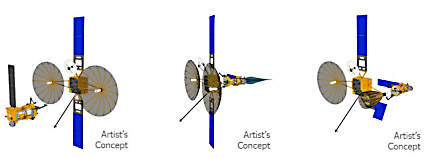'Concrete step' toward robotic satellite repairs to involve industry
DARPA looks to develop a public/private partnership to develop a craft that could inspect and repair satellites in geostationary Earth orbit.

DARPA plans a robotic craft that could inspect spacecraft, help with adjusting orbits and fix mechanical problems.
Military researchers are continuing their quest to find a way to use robots to service satellites in geostationary Earth orbit (GEO), and they want to bring industry into the project.
The Defense Advanced Research Projects Agency, which has been researching space robotics for more than a decade, is mulling a flight in the next five years to demonstrate its technologies, and wants to develop a public/private partnership to get it off the ground.
Noting that the majority of GEO satellites are commercially owned, the agency has issued a Request for Information looking for technical, security and business ideas on the program. A successful cooperative robots program would not only improve the lifespans and reliability of satellites but significantly bring down costs for both military and commercial operators, DARPA said.
“We’re asking the space community to think hard about how they want the future of space operations to look and how GEO robotics could help,” Gordon Roesler, DARPA program manager, said in a statement. “Their insights are essential as we take the first concrete steps toward viable satellite-servicing capabilities in GEO.”
Objects in low Earth orbit (between 99 and 1,200 miles above the Earth) have been repaired or upgraded while in orbit before. The Hubble Space Telescope, for instance, received service calls from space shuttle astronauts five times between 1993 and 2009. But satellites in GEO travel at about 22,000 miles above the Earth, out of the reach of current technologies. Those satellites must be made to function on their own without maintenance for their lifetimes, so they must be bigger, more complex—and more costly.
The agency wants to develop a partnership with commercial operators to develop near-term technologies and create a commercially owned space robotics operation that would provide service to both the military and private industry on a fee-for-service basis.
Building on DARPA technologies such as those developed in its Phoenix program, the agency plans to develop what it calls a robotic servicer that would operate in GEO and be able to inspect orbiting spacecraft, make repairs such as resetting solar arrays and antennas, and make course corrections including repositioning a satellite or moving it to a disposal orbit.
“Creating a public-private partnership is an innovative way to ensure that GEO robotic servicing gets community buy-in to succeed long term,” Roesler said.
Public/private partnerships and other new acquisition strategies are something space-related agencies are starting to pursue more aggressively, as the costs of launching and operating satellites skyrocket and federal budgets shrink. DARPA’s Experimental Spaceplane, or XS-1, program, which seeks to develop a modular, reusable sub-orbital plane for launching LEO satellites, is working with three company teams separately developing a prototype of the plane.
The Air Force also is taking a new approach toward finding a domestically produced rocket engine for its national security space launches, which currently rely on the Russian-made RD-180 engine.
And NASA, tired of having to hitch rides to the International Space Station aboard Russian Soyuz spacecraft (at about $70 million per seat), will fund the development of a commercially owned launch “space taxi” service.
Such public-private partnerships fall in line with the administration’s National Security Space Strategy of 2011, which advocates the partnerships as a way to keep costs down while improving of satellites and other space craft.